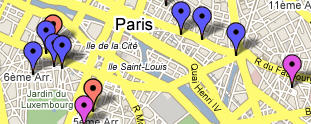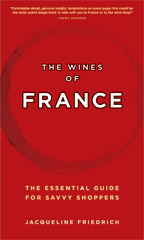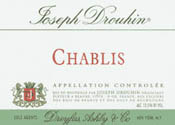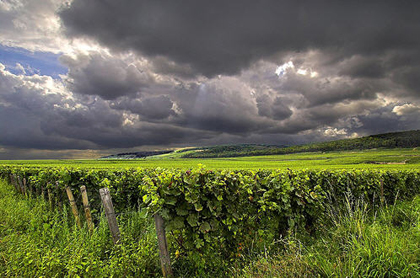Dr Vino's wine blog
wine talk that goes down easy
Bobby Kacher pulls a Gascon rabbit out of his hat
As the dollar falls further, wine importers have to dig deeper for values from the eurozone. For some consumers, that means: goodbye Burgundy, hello…Gascony?
At a media event last week, I tasted the excellent value white wines from Tariquet (priced $8 – $15) that well-known francophile Bobby Kacher is now importing. On the whole, they are rare steals in a world of more expensive wines. When I asked him how he found such good values, Kacher told me “We’re old. Money isn’t everything.” If he weren’t running his business as charity for frugal enophiles, I’d have said that he must be a magician to find values today–and he’d probably pair Sauvignon Blanc with the rabbit he pulled out of his metaphorical hat.
 Look for the “Classic,” the Sauvignon Blanc and the Côté Tariquet, a late-ish harvest wine. Yves Grassa, the head of Tariquet (and Domaine de Pouy, another Kacher value) cut yields, and harvests them directly into mobile cooling units so that he doesn’t need to add sulfur to prevent fermentation from starting in the vineyard.
Look for the “Classic,” the Sauvignon Blanc and the Côté Tariquet, a late-ish harvest wine. Yves Grassa, the head of Tariquet (and Domaine de Pouy, another Kacher value) cut yields, and harvests them directly into mobile cooling units so that he doesn’t need to add sulfur to prevent fermentation from starting in the vineyard.
In a celebration of all things Gascon (complete with grumbling about the rugby), Ariane Daugin of D’Artagnan was there and we sampled some of the company’s fine meats. Fortunately I brought my Rapid Review (TM) software with and could generate these nuggets for you: Read more…
Paris wine shops, a map!

Are you in Paris today during the 24-hr public sector strike and wondering what to do? Why, set up a wine-drenched itinerary of local wine shops! Check out my brand new map of Paris wine stores–and wine bars that sell wines to go!
I give you the scoop on over 40 places including my faves, ranging from neighborhood places to super-luxury stops. If you’re a local looking for “natural” wines or a tourist looking for wines you can’t find at home, click through to start setting up your own itinerary for your next visit!
Is one of yours not on the map? Drop me a line with the address and why you think it should be included.
Related: Bringing wine back with you from France
Paris/France wine round-up
All posts in French wine
The map room
Grenache, the ultimate back-up player, breaks out

In the chorus of Rhone varieties, Grenache rarely gets to perform solo. But at the most recent lunch for the Wine Media Guild in New York City, we put it on a stage all alone with twenty five examples of the grape from five countries.
Which is the most planted red grape variety in the world? According to our speaker and grenache-o-phile, Jean-Francois Ey, it’s grenache. The grape often appeals to winegrowers because of it’s workhorse-like productivity in early years of the life of the vine. But it may appeal to consumers, particularly as the vine ages, because of wines light in tannin that can have a faint sweetness and high degree of alcohol. Even though the day of our tasting was still warm, it strikes me now as an excellent transitional red as the weather has cooled.
Our tasting consisted exclusively of old-vine grenache. “Old vine” appears to be the wine label term du jour and producers toss it around–like “reserve”–with so little regulation. Jean-Francois, 30, imports several wines from Roussillon under the Ey Vineyards label and put the question of age into perspective for Grenache. In the Mediterranean climate (with no irrigation or fertilizer), the vines take five years just to get going. Then they have 25 bountiful years with abundant yields. But as the vines age, he said, they yields become so miserly that one vine produces enough fruit for just one bottle of wine. At 30-35 years of age, a producer can make good money but after 50 years, they will make good quality he said.
Turning to the wines, we had two white grenache, one rose, several 100% red grenache and some blends, and finally a Banyuls sweet wine. Read more…
Talking Champagne with Peter Liem of Wine & Spirits
 Is the world running out of Champagne? Such is what a panicked headline in the Guardian implied recently.
Is the world running out of Champagne? Such is what a panicked headline in the Guardian implied recently.
Indeed, Champagne is the most effervescent region in France, a winemaking country where practically every other region is affected by la crise viticole. Peter Liem, Senior Correspondent for Wine & Spirits magazine, is so interested in Champagne that he left New York earlier this year to move there. I caught up with him via email about what’s happening on the ground. He talks in detail about the effects of the phenomenal demand for Champagne and offers his picks for reasonably priced bubbly here in the States–as well as ones only available in France. Read more…
Overheard: if you are biodynamic, you’re not making wine in 2007
“We’ll see who are the real biodynamic producers this year. If they’re really biodynamic, this year they won’t have any wine.”
Such was the provocative statement a French wine insider told me last week. He was referring to the gray and damp vintage of 2007 in France. Time will tell.
The reason that it’s tough for biodynamic producers is that various vine maladies can creep in with rain. Treating them with chemicals is fairly easy, treating them without chemicals, as is the wont of BioD producers, is very labor intensive–or impossible, as this guy was implying.
Related:
“Bordeaux vineyards lose 90% of crop as rain and rot threaten French harvests” [Decanter.com]
“Bordeaux 2007 in progress: weather” [Dr. V]
(image, with permission)
The Wines of France, by Jacqueline Friedrich
 The wines of France in 360 compact pages? Heck, I’ve read a book longer than that on one region, the Loire! That was my incredulous reaction when I first spotted The Wines of France: The Essential Guide for Savvy Shoppers by Jacqueline Friedrich across the room at Barnes & Noble.
The wines of France in 360 compact pages? Heck, I’ve read a book longer than that on one region, the Loire! That was my incredulous reaction when I first spotted The Wines of France: The Essential Guide for Savvy Shoppers by Jacqueline Friedrich across the room at Barnes & Noble.
But upon closer inspection, what this svelte paperback ($13.75 on Amazon) sacrifices in depth, it makes up for in breadth. Friedrich has no shortage of tasting experience–or opinions–and wheels around her quick tour de France in what is essentially an annotated directory. She dispenses with such page-consuming graphics as maps, label images or chateau pictures. Divided into regions, each section leads with a one page overview and then heads straight into an alphabetical listing of producers and subregions. Her favorite producers receive a star, ones to watch get an up arrow, and she usually notes in the text if a producer is “eco-friendly” or not.
This is great for skimming and finding an instant nugget of information, as I could see a flummoxed sommelier or shopkeeper doing. Or you can say “hey what is this Vouvray region I’ve been reading about?” for example. Bam–a couple of ‘grafs on Vouvray and a list of her favorite producers including a paragraph on her six faves (Aubuisieres, Champalou, Chidaine, Gaudrelle, Huet, and Clos Naudin/Foreau for all you Vouvray junkies out there). This can be great for setting up an itinerary. But once there, you may want more info on the producers, which is possible in this case to get from Friedrich since she wrote that 400-page book on the Loire. So when can we expect other regional guides from Friedrich?
So just how are those opinions that she hands out with such ease? Well, they seem quite good on the whole–to wit, I had not tried the Chateau des Jacques wines from Beaujolais that she was rhapsodic about and included them in my recent Bojo tasting and I was very glad I did. However, the parsimony of the star system on display in the tiny Vouvray breaks down in areas where there are many good producers. Consider St. Emilion, where no fewer than 28 producers receive stars. This isn’t an undue amount, but it’s just that fast simplicity is lost. She goes some distance to making up for that with her “Bordeaux crib sheet,” which again narrows the field and includes many worthwhile producers. She seems to punt on the extracted/not-extracted issue, starring the likes of Bon Pasteur and Pavie, while commenting that the controversial 03 Pavie tasted “port-like.”
Ten months on from the publication date, as the 06s have been harvested and the 07s are about to be, I have only one question: what are the chances of getting a 2008 update to this handy little reference?
Get your Bojo working – cru Beaujolais in the height of summer
 In 1395, Philip the Bold, Duke of Burgundy, was so afraid of gamay that he banned it. That’s right: a man named “the bold” feared a grape. You need to use his fear to your advantage.
In 1395, Philip the Bold, Duke of Burgundy, was so afraid of gamay that he banned it. That’s right: a man named “the bold” feared a grape. You need to use his fear to your advantage.
Philip was afraid that gamay would encroach on the turf of pinot noir, the native red grape of his home area. And indeed it might: high in acidity with red fruit notes and very food friendly, you could easily see why the Duke of Burgundy might be running scared.
 So over the weekend, we had some friends over to the Dr. Vino World Headquarters and tried a dozen Beaujolais. There are ten small appellations, or growing areas in the region, and we didn’t quite cover all of them. But it was a representative enough sample to get a lay of the land, something that definitely merits your attention, as blogger Neil is doing tasting through two wines from each appellation.
So over the weekend, we had some friends over to the Dr. Vino World Headquarters and tried a dozen Beaujolais. There are ten small appellations, or growing areas in the region, and we didn’t quite cover all of them. But it was a representative enough sample to get a lay of the land, something that definitely merits your attention, as blogger Neil is doing tasting through two wines from each appellation.
Since we live in a capitalist economy, I let the invisible hand take control of structuring the tasting, letting the friends bring whatever they found instead of trying to dictate which wines to bring. The distribution was surprisingly even with good representation of the appellations. I should note, however, that it wasn’t always easy finding them. For example, one friend reported that he asked for some cru Beaujolais at a respected store and the first clerk didn’t know what he meant (fortunately another did). And I went to an off-the-beaten-path store where the owner told me that he didn’t stock much French wine in part because the dollar made it more expensive (the other part was for patriotic reasons–does that sentiment still exist?!?). While that may be true from a currency exchange standpoint, it’s hardly the case for cru Beaujolais, which is almost entirely between $12 and $25. Read more…
Wine Blogging Wednesday – Unoaked Chardonnay – Drouhin Chablis
Unoaked chardonnay is all the rage. When wine drinkers started dumping oaked California chardonnay and turning to unoaked, fruit-forward whites such as pinot grigio and sauvignon blanc, they threatened to throw the baby out with the oaky bathwater. But chardonnay has lived to see another day in its new, unoaked form.
 But is it new in the Old World? In Chablis and various parts of Burgundy, the chardonnay grape often sees little oak. So when Lenn, the grandpappy of Wine Blogging Wednesday, assigned us unoaked chardonnay for this 36th, anniversary edition, my thoughts turned to Chablis. But which of them is made totally without oak as opposed to simply old, neutral oak?
But is it new in the Old World? In Chablis and various parts of Burgundy, the chardonnay grape often sees little oak. So when Lenn, the grandpappy of Wine Blogging Wednesday, assigned us unoaked chardonnay for this 36th, anniversary edition, my thoughts turned to Chablis. But which of them is made totally without oak as opposed to simply old, neutral oak?
I’m not sure about that, but I managed to find one that is fermented in stainless steel: Drouhin Chablis 2006, about $17 (find this wine). The resulting wine is lean and light, with good acidity, notes of lemon, lanolin and minerality with a retrograde 12.5% alcohol. It’s a very pleasant for summer wine.
Head on over to Lenndevours.com for a roundup of unoaked chardonnays from other participants in this edition of Wine Blogging Wednesday.




